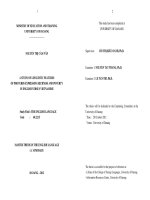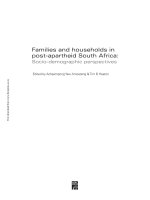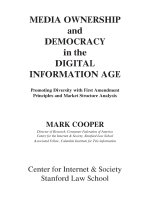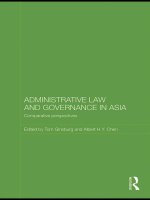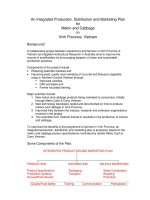Corporate entrepreneurship, ownership and governance in post privatisation vietnam
Bạn đang xem bản rút gọn của tài liệu. Xem và tải ngay bản đầy đủ của tài liệu tại đây (7.49 MB, 292 trang )
Corporate Entrepreneurship,
Ownership and Governance in PostPrivatisation Vietnam
A Thesis Submitted to The University of Manchester
for the Degree of Doctor of Philosophy (PhD)
in the Faculty of Humanities
2015
THI MY HUONG NGUYEN
Manchester Business School
List of Contents
LIST OF TABLES ............................................................................................................................................ 8
LIST OF FIGURES ........................................................................................................................................ 10
ABSTRACT
11
DECLARATION 12
COPYRIGHT STATEMENT ............................................................................................................................ 12
ACKNOWLEDGEMENTS .............................................................................................................................. 14
ABOUT THE AUTHOR ................................................................................................................................. 15
CHAPTER 1:
INTRODUCTION................................................................................................................... 16
1.1.
INTRODUCTION ........................................................................................................................ 17
1.2.
RESEARCH BACKGROUND .......................................................................................................... 17
1.3.
RESEARCH OBJECTIVES AND RESEARCH QUESTIONS ...................................................................... 20
1.4.
STRUCTURE OF THE THESIS ......................................................................................................... 20
CHAPTER 2:
VIETNAM: CONTEXT, PRIVATISATION AND CORPORATE GOVERNANCE ................................ 22
2.1.
INTRODUCTION ........................................................................................................................ 23
2.2.
OVERVIEW OF VIETNAMESE ECONOMY ........................................................................................ 23
2.2.1.
Political Context and Economic Transition ........................................................................... 23
2.2.1.1.
Before 1975............................................................................................................................. 23
2.2.1.2.
1975─85 .................................................................................................................................. 23
2.2.1.3.
1986─99 .................................................................................................................................. 24
2.2.1.4.
After 2000 ............................................................................................................................... 26
2.2.2.
Institutional Environment.................................................................................................... 26
2.2.2.1.
Formal Institutions ................................................................................................................... 27
2.2.2.2.
Informal Institutions ................................................................................................................. 28
2.3.
ENTREPRENEURSHIP IN VIETNAM ................................................................................................. 29
2.4.
PRIVATISATION, OWNERSHIP STRUCTURE AND BOARD GOVERNANCE ........................................... 31
2.4.1.
2.4.1.1.
Privatisation Process ................................................................................................................ 31
2.4.1.2.
Key Features of Vietnamese Privatisation ................................................................................. 33
2.4.2.
2.5.
Privatisation........................................................................................................................ 31
Corporate Governance ........................................................................................................ 34
2.4.2.1.
Corporate Governance Regulations in Vietnam ........................................................................ 34
2.4.2.2.
Key Stakeholders of Privatised Firms........................................................................................ 37
2.4.2.3.
Ownership Structure ............................................................................................................... 39
2.4.2.4.
Board Governance................................................................................................................... 39
CONCLUSIONS .......................................................................................................................... 40
2
CHAPTER 3:
PREVIOUS RESEARCH.......................................................................................................... 41
3.1.
INTRODUCTION ........................................................................................................................ 42
3.2.
CORPORATE ENTREPRENEURSHIP LITERATURE .............................................................................. 42
3.2.1.
Definition of Entrepreneurship ............................................................................................ 42
3.2.2.
Definition of Corporate Entrepreneurship ........................................................................... 44
3.2.3.
Corporate Entrepreneurship and its Characteristics ............................................................. 46
3.3.
CORPORATE GOVERNANCE ANTECEDENTS OF CORPORATE ENTREPRENEURSHIP ............................. 48
3.3.1.
Corporate Governance, Ownership Structure and Related Definitions ................................. 48
3.3.2.
Theoretical Paradigms......................................................................................................... 49
3.3.3.
Board Governance and Corporate Entrepreneurship ........................................................... 51
3.3.3.1.
CEO Duality ............................................................................................................................ 51
3.3.3.2.
Representation of TMT Members ............................................................................................ 53
3.3.3.3.
Representation of Outside Directors ....................................................................................... 54
3.3.3.4.
Board Size ............................................................................................................................... 56
3.3.4.
Ownership Structure and its Effects on Corporate Entrepreneurship ................................... 58
3.3.4.1.
Managerial Ownership ............................................................................................................. 58
3.3.4.2.
Institutional Ownership ........................................................................................................... 60
3.3.4.3.
Concentrated Ownership ........................................................................................................ 62
3.3.5.
Board Monitoring................................................................................................................ 63
3.3.6.
Moderating Effects of Environmental Uncertainty ............................................................... 65
3.3.6.1.
Dynamism ............................................................................................................................... 66
3.3.6.2.
Heterogeneity ......................................................................................................................... 67
3.3.6.3.
Hostility .................................................................................................................................. 67
3.4.
CONCLUSION ........................................................................................................................... 68
CHAPTER 4:
THEORETICAL BACKGROUND AND HYPOTHESES ................................................................ 69
4.1.
INTRODUCTION ........................................................................................................................ 70
4.2.
CONCEPTUAL FRAMEWORK AND THEORETICAL BACKGROUND ..................................................... 70
4.2.1.
Conceptual Framework ....................................................................................................... 70
4.2.2.
Theoretical Background ...................................................................................................... 72
4.2.2.1.
Agency Theory ........................................................................................................................ 72
4.2.2.2.
Agency versus Stewardship Theory .......................................................................................... 72
4.2.2.3.
Agency Theory versus Resource Dependence Theory.............................................................. 74
4.2.2.4.
Agency Theory versus Institutional Theory .............................................................................. 75
4.3.
HYPOTHESES ............................................................................................................................. 76
4.3.1.
Corporate Governance Hypotheses ..................................................................................... 77
4.3.1.1.
CEO Duality ............................................................................................................................ 77
4.3.1.2.
Representation of TMT Members ............................................................................................ 79
4.3.1.3.
Representation of Outside Directors ....................................................................................... 80
4.3.1.4.
Board Size ............................................................................................................................... 81
3
4.3.2.
Ownership Structure Hypothesis ......................................................................................... 83
4.3.2.1.
Managerial Ownership ............................................................................................................. 83
4.3.2.2.
Institutional Ownership ........................................................................................................... 84
4.3.2.3.
Ownership Concentration ....................................................................................................... 85
4.3.3.
Board Monitoring................................................................................................................ 87
4.3.4.
Moderating Effects of Environmental Uncertainty ............................................................... 87
4.3.4.1.
Dynamism ............................................................................................................................... 88
4.3.4.2.
Heterogeneity ......................................................................................................................... 89
4.3.4.3.
Hostility .................................................................................................................................. 90
4.4.
CONCLUSION ........................................................................................................................... 91
CHAPTER 5:
RESEARCH STRATEGY AND METHODOLOGY ....................................................................... 93
5.1.
INTRODUCTION ........................................................................................................................ 94
5.2.
RESEARCH STRATEGY ................................................................................................................. 94
5.2.1.
Research Philosophy ........................................................................................................... 94
5.2.2.
Mixed-Methods Strategy ..................................................................................................... 96
5.3.
THE EXPLORATORY RESEARCH STAGE ......................................................................................... 98
5.4.
SURVEY METHOD ...................................................................................................................... 99
5.4.1.
Research Design ............................................................................................................... 100
5.4.2.
Sampling and Data Collection............................................................................................ 100
5.4.3.
Survey Instrument............................................................................................................. 103
5.4.3.1.
Questionnaire Design ............................................................................................................ 103
5.4.3.2.
Variables and Measures .......................................................................................................... 104
5.4.4.
Methods and Models ......................................................................................................... 109
5.4.4.1.
Analytic Procedures ............................................................................................................... 109
5.4.4.2.
Regression Diagnostics .......................................................................................................... 110
5.5.
CASE STUDY METHOD ............................................................................................................. 110
5.5.1.
Case Study Design ............................................................................................................ 110
5.5.2.
Case Study Selection ......................................................................................................... 111
5.5.3.
Data Collection and Interview Instrument......................................................................... 114
5.5.3.1.
Data Collection ..................................................................................................................... 114
5.5.3.2.
Research Questions and Interview Protocol........................................................................... 115
5.6.
CONCLUSIONS ........................................................................................................................ 116
CHAPTER 6:
ANALYSIS OF SURVEY DATA ............................................................................................. 118
6.1.
INTRODUCTION ...................................................................................................................... 119
6.2.
SCALE REFINEMENT AND RELIABILITY ......................................................................................... 119
6.3.
DESCRIPTIVE STATISTICS AND CORRELATIONS ............................................................................ 122
6.3.1.
Description of Sample ....................................................................................................... 122
6.3.2.
Descriptive Statistics and Correlations ............................................................................... 123
4
6.4.
RESULTS ................................................................................................................................. 127
6.4.1.
The Effects of Board Governance on Corporate Entrepreneurship ..................................... 127
6.4.1.1.
CEO Duality .......................................................................................................................... 127
6.4.1.2.
Representation of TMT Members .......................................................................................... 127
6.4.1.3.
Representation of Independent Outside Directors ................................................................. 128
6.4.1.4.
Board Size ............................................................................................................................. 128
6.4.2.
The Effects of Ownership Structure on Corporate Entrepreneurship .................................. 129
6.4.2.1.
Managerial Ownership ........................................................................................................... 129
6.4.2.2.
Institutional Ownership ......................................................................................................... 129
6.4.2.3.
Ownership Concentration ..................................................................................................... 129
6.4.3.
The Effects of Board Monitoring on Corporate Entrepreneurship ...................................... 129
6.4.4.
Moderating Effects of Environmental Factors .................................................................... 133
6.4.4.1.
Moderating Effects of Dynamism .................................................................................. 133
6.4.4.2.
Moderating Effects of Heterogeneity ............................................................................ 134
6.4.4.3.
Moderating Effects of Hostility ..................................................................................... 135
6.5.
DISCUSSION ............................................................................................................................ 139
6.5.1.
Board Governance and Corporate Entrepreneurship ......................................................... 139
6.5.1.1.
CEO Duality .......................................................................................................................... 139
6.5.1.2.
Representation of TMT Members .......................................................................................... 140
6.5.1.3.
Representation of Independent Outside Directors ................................................................. 141
6.5.1.4.
Board Size ............................................................................................................................. 142
6.5.2.
Ownership Structure and Corporate Entrepreneurship ...................................................... 143
6.5.2.1.
Managerial Ownership ........................................................................................................... 143
6.5.2.2.
Institutional Ownership ......................................................................................................... 144
6.5.2.3.
Ownership Concentration ..................................................................................................... 145
6.5.3.
Board Monitoring.............................................................................................................. 146
6.5.4.
Moderating Effects of Environment................................................................................... 146
6.6.
CONCLUSIONS ........................................................................................................................ 148
CHAPTER 7:
INTRODUCTION TO THE CASE STUDIES ............................................................................. 150
7.1.
INTRODUCTION ...................................................................................................................... 151
7.2.
CASE REPORTS ........................................................................................................................ 151
7.2.1.
Capital-intensive Industry Cases ........................................................................................ 154
7.2.1.1.
Overview of the Industry ....................................................................................................... 154
7.2.1.2.
CapitalHigh............................................................................................................................ 155
7.2.1.3.
CapitalLow ............................................................................................................................ 157
7.2.2.
Knowledge-intensive Industry Cases.................................................................................. 159
7.2.2.1.
Construction Industry and KnowledgeHigh ............................................................................ 159
7.2.2.2.
Environmental and Pollution Control Equipment and Services and KnowledgeLow ................. 162
7.2.3.
Labour-intensive Industry Cases ........................................................................................ 164
7.2.3.1.
Overview of the Industry ....................................................................................................... 164
5
7.2.3.2.
LabourHigh............................................................................................................................ 165
7.2.3.3.
LabourLow ............................................................................................................................ 167
7.3.
CONCLUSIONS ........................................................................................................................ 169
CHAPTER 8:
CASE STUDY ANALYSIS...................................................................................................... 170
8.1
INTRODUCTION ...................................................................................................................... 171
8.2
CASE ANALYSIS PROCEDURE ..................................................................................................... 171
8.3
EXPLANATION OF THE FINDINGS IN THE SURVEY STUDY .............................................................. 173
8.3.1.
Board Governance and Long-term Decisions .................................................................... 173
8.3.1.1.
CEO Duality .......................................................................................................................... 173
8.3.1.2.
Representation of TMT Members .......................................................................................... 176
8.3.1.3.
Representation of Independent Outside Directors ................................................................. 179
8.3.1.4.
Board Size ............................................................................................................................. 182
8.3.2.
Ownership Structure and Corporate Entrepreneurship .................................................... 183
8.3.2.1.
Managerial Ownership ........................................................................................................... 183
8.3.2.2.
Institutional Ownership ......................................................................................................... 187
8.3.2.3.
Ownership Concentration ..................................................................................................... 188
8.3.3.
8.4
Board Monitoring.............................................................................................................. 191
EMERGING THEMES FROM CASE STUDY ANALYSIS ....................................................................... 193
8.4.1.
CEO versus Board Power ................................................................................................. 193
8.4.2.
Non-ownership Directors................................................................................................. 194
8.4.3.
Board Ownership ............................................................................................................. 195
8.4.4.
Affiliated Outside Directors .............................................................................................. 197
8.4.5.
Take-over by Institutional Owners .................................................................................... 198
8.5
COMPARATIVE CASE STUDY DISCUSSION ................................................................................... 199
8.5.1.
High/low Capital-intensive Cases....................................................................................... 199
8.5.2.
High/low Knowledge-intensive Cases ................................................................................ 200
8.5.3.
High/low Labour-intensive Cases ...................................................................................... 201
8.6
MODERATING EFFECT OF STATE OWNERSHIP ............................................................................. 202
8.6.1.
The Moderating Role of State Ownership ......................................................................... 202
8.6.2.
Results and Discussion ...................................................................................................... 203
8.7.
CONCLUSIONS ........................................................................................................................ 208
CHAPTER 9:
CONCLUSIONS, IMPLICATIONS AND FUTURE RESEARCH................................................... 210
9.1.
INTRODUCTION ...................................................................................................................... 211
9.2.
LIMITATIONS ........................................................................................................................... 211
9.3.
KEY FINDINGS ......................................................................................................................... 213
9.4.
CONTRIBUTIONS ..................................................................................................................... 219
9.5.
POLICY AND MANAGERIAL IMPLICATIONS .................................................................................. 224
9.6.
FURTHER RESEARCH................................................................................................................. 227
6
ANNEX .............................................................................................................................................. 229
Annex 1: Key Events Affecting Corporate Governance in Vietnamese Privatised Firms ................... 229
Annex 2: Some Prominent Definitions ............................................................................................ 230
Annex 3: A Summary of Literature Review on the Relationships Between Ownership Structure/ Board
Attributes and Organisational Outcomes ........................................................................................ 231
Annex 4: List of Participants in Exploratory Study Phase ................................................................. 236
Annex 5: Interview Protocols in Exploratory Study ......................................................................... 236
Annex 6: Cover Letter ................................................................................................................... 237
Annex 7: Questionnaire in English .................................................................................................. 238
Annex 8: Questionnaire in Vietnamese ........................................................................................... 243
Annex 9: Information Sheet in English ............................................................................................. 247
Annex 10: Information Sheet in Vietnamese .................................................................................... 252
Annex 11: Translation, Expert Review and Pre-testing .................................................................... 256
Annex 12: Lists of Participants in Designing Questionnaire ............................................................. 259
Annex 13: Pre-testing Protocol....................................................................................................... 259
Annex 14: Operationalization of CE Measures ................................................................................ 260
Annex 15: Item Pool of CE Measures by Zahra (1996) and Zahra (2000) ........................................ 262
Annex 16: Selection of Items for CE Measures................................................................................ 263
Annex 17: Environmental Dimensions............................................................................................. 264
Annex 18: Selection of Item Pools for Environment Measures ........................................................ 265
Annex 19: Interview Protocol for Board Members.......................................................................... 267
Annex 20: Interview Protocol for TMT Members ........................................................................... 269
REFERENCES ...................................................................................................................................... 271
Word-Count
Including Footnotes, Tables, and Textboxes
but Excluding Annexes: –79.708–
7
List of Tables
TABLE 1: KEY MILESTONES IN TRANSITION PROCESS OF VIETNAM ’S ECONOMY .................................................. 25
TABLE 2: ECONOMIC DEVELOPMENT, 1991─99 .............................................................................................. 25
TABLE 3: KEY ECONOMIC INDICATORS, 2000─10 ........................................................................................... 26
TABLE 4: MILESTONES IN EQUITIZATION IN VIETNAM ...................................................................................... 31
TABLE 5: SUMMARY OF HYPOTHESES TESTED IN THIS STUDY............................................................................. 92
TABLE 6: THREE RESEARCH STAGES................................................................................................................ 98
TABLE 7: SUMMARY OF THE DATA COLLECTION ACTIVITIES ........................................................................... 102
TABLE 8: CORPORATE ENTREPRENEURSHIP SCALE ......................................................................................... 105
TABLE 9: DESCRIPTION OF INDEPENDENT VARIABLES ..................................................................................... 106
TABLE 10: ENVIRONMENTAL DIMENSIONS .................................................................................................... 107
TABLE 11: RESEARCH QUESTIONS AND INTERVIEW DATA .............................................................................. 115
TABLE 12: SUBSCALE ITEMS WITH OBLIQUE ROTATED FACTOR LOADINGS AND RELIABILITY COEFFICIENTS FOR
EACH SUBSCALE OF CE MEASURES ............................................................................................................... 120
TABLE 13: SUBSCALE ITEMS WITH OBLIQUE ROTATED FACTOR LOADINGS AND RELIABILITY COEFFICIENTS FOR
EACH SUBSCALE OF ENVIRONMENT MEASURES.............................................................................................. 121
TABLE 14: SUBSCALE ITEMS WITH OBLIQUE ROTATED FACTOR LOADINGS AND RELIABILITY COEFFICIENTS FOR
EACH SUBSCALE OF BOARD
MONITORING ................................................................................................... 122
TABLE 15: CHARACTERISTICS OF SAMPLED FIRMS AND DEMOGRAPHICS OF RESPONDENTS ................................ 123
TABLE 16: DESCRIPTIVE STATISTICS .............................................................................................................. 124
TABLE 17: CORRELATIONS BETWEEN VARIABLES ........................................................................................... 125
TABLE 18: RESULTS OF REGRESSIONS FOR INNOVATION ................................................................................. 130
TABLE 19: RESULTS OF REGRESSIONS FOR BUSINESS VENTURING ..................................................................... 131
TABLE 20: RESULTS OF REGRESSION ANALYSIS FOR STRATEGIC RENEWAL ........................................................ 132
TABLE 21: RESULTS OF MODERATED REGRESSION ANALYSIS FOR INNOVATION ................................................ 136
TABLE 22: RESULTS OF MODERATED REGRESSION ANALYSIS FOR BUSINESS VENTURING .................................... 137
TABLE 23: RESULTS OF MODERATED REGRESSION ANALYSIS FOR STRATEGIC RENEWAL .................................... 138
TABLE 24: A SUMMARY OF EMPIRICAL FINDINGS FOR ALTERNATIVE HYPOTHESES ............................................. 139
TABLE 25: DESCRIPTION OF CASE DATA ...................................................................................................... 153
TABLE 26: CORPORATE GOVERNANCE AND OWNERSHIP STRUCTURE OF CASES IN CAPITAL-INTENSIVE INDUSTRY
................................................................................................................................................................ 157
TABLE 27: CORPORATE GOVERNANCE AND OWNERSHIP STRUCTURE OF CASES IN KNOWLEDGE-INTENSIVE
INDUSTRY ................................................................................................................................................. 162
TABLE 28: CORPORATE GOVERNANCE AND OWNERSHIP STRUCTURE OF CASES IN LABOUR-INTENSIVE INDUSTRY
................................................................................................................................................................ 167
TABLE 29. DESCRIPTIVE INFORMATION FOR RESPONDENTS ............................................................................ 172
TABLE 30: OWNERSHIP CONCENTRATION OF THE CASES IN THE SAMPLE (THREE-YEAR AVERAGE) ...................... 189
8
TABLE 31: RESULTS OF REGRESSIONS FOR INNOVATION ................................................................................. 205
TABLE 32: RESULTS OF REGRESSIONS FOR BUSINESS VENTURING ..................................................................... 206
TABLE 33: RESULTS OF REGRESSION ANALYSIS FOR STRATEGIC RENEWAL ........................................................ 207
TABLE 34: SUMMARY OF RESEARCH FINDINGS ............................................................................................... 215
9
List of Figures
FIGURE 1: NUMBER OF NEWLY REGISTERED ENTERPRISES ................................................................................... 30
FIGURE 2: NUMBER OF EQUITIZED SOES......................................................................................................... 33
FIGURE 3: MANAGEMENT STRUCTURE OF JOINT-STOCK COMPANY .................................................................... 35
FIGURE 4: HIERARCHY OF TERMINOLOGY IN CORPORATE ENTREPRENEURSHIP .................................................... 45
FIGURE 5: THE DOMAINS OF CORPORATE ENTREPRENEURSHIP ........................................................................... 46
FIGURE 6: INTRAPRENEURSHIP MODEL AND ITS EFFECTS .................................................................................... 47
FIGURE 7: MULTI-THEORETICAL APPROACH TO OWNERSHIP–PERFORMANCE RELATIONSHIPS AMONG fiRMS IN AN
EMERGING ECONOMY CONTEXT; SOURCE: PERSONAL ADAPTATION OF DOUMA ET AL. (2006) ............................. 72
FIGURE 8: RESEARCH QUESTIONS, VARIABLES OF INTEREST AND THEORIES ......................................................... 91
FIGURE 9: VISUAL MODEL FOR DESIGN PROCEDURES ...................................................................................... 117
FIGURE 10: BUSINESS VENTURING AS A FUNCTION OF THE INTERACTION OF DYNAMISM AND TMT BOARD
MEMBERSHIP
.............................................................................................................................................. 133
FIGURE 11: PLOTS OF INNOVATION AS A FUNCTION OF THE INTERACTION OF HETEROGENEITY AND BOARD SIZE 134
FIGURE 12: PLOTS OF STRATEGIC RENEWAL AS A FUNCTION OF THE INTERACTION OF HETEROGENEITY AND BOARD
SIZE .......................................................................................................................................................... 135
FIGURE 13: PLOTS OF BUSINESS VENTURING AS A FUNCTION OF THE INTERACTION OF HOSTILITY AND
INSTITUTIONAL OWNERSHIP ........................................................................................................................ 135
FIGURE 14: PHARMACEUTICAL MARKET POTENTIAL OF EMERGING MARKETS AND MATURE MARKETS; ................... 154
FIGURE 15: ESTIMATION OF CONSTRUCTION SPENDING GROWTH IN ASIA FROM 2013 TO 2018........................ 160
FIGURE 16: VIETNAMESE TEXTILES AND GARMENTS EXPORT REVENUE IN 2005-12 ............................................. 165
FIGURE 17: PLOTS OF STRATEGIC RENEWAL AS A FUNCTION OF THE INTERACTION OF STATE OWNERSHIP AND
BOARD SIZE ............................................................................................................................................... 203
FIGURE 18 : GRAPHIC REPRESENTATION OF STAGES OF TRANSLATION AND CULTURAL ADAPTATION; SOURCE :
BEATON ET AL. (2000) ............................................................................................................................... 257
10
Abstract
Corporate entrepreneurship, Ownership and Governance in
Post-privatisation Vietnam
A thesis submitted for the degree of Doctor of Philosophy (PhD)
by Thi My Huong Nguyen
2015
The University of Manchester
This dissertation investigates the following questions. How does the structure of ownership, board
governance, and board monitoring influence the corporate entrepreneurship (CE) behaviour of
privatised firms in Vietnam? Furthermore, does uncertainty regarding the changing business and
institutional environment moderate the relationships among corporate governance, ownership
structure, and CE?
In the dissertation, Stewardship Theory, Institutional Theory, Resource Dependence Theory, are
integrated with Agency Theory to provide a framework to investigate the relationships between
board composition, ownership structure and CE in post-privatisation environments. The
theoretical arguments are tested using a mixed-method approach, based on a survey of privatised
Vietnamese firms and data collected and collated from in-depth interviews of board and top
management team members in six selected privatised firms. The study findings indicate that a
reliance on any single theoretical lens is ineffective in explaining the phenomenon in the context
of privatised firms in transition economies, and that the employment of multiple theories is crucial
for providing a complete understanding of context-dependent phenomena, such as corporate
governance. Empirically, the results show that the board composition and characteristics have
little impact on CE and ownership structure almost plays no role in enhancing the entrepreneurial
activities of privatised firms. In particular, the study highlights that there are no unique corporate
governance practices that can be employed in every context. The practices are effective only in
certain conditions and specific environments. The study provides a set of policy and managerial
implications for shaping corporate governance in order to foster CE in Vietnamese privatised
firms.
11
Declaration
No portion of the work referred to in the thesis has been submitted in support of an application
for another degree or qualification of this or any other university or other institute of learning.
Copyright Statement
The author of this thesis (including any appendices and/or schedules to this thesis) owns certain
copyright or related rights in it (the “Copyright”) and s/he has given The University of Manchester
certain rights to use such Copyright, including for administrative purposes.
Copies of this thesis, either in full or in extracts and whether in hard or electronic copy, may be
made only in accordance with the Copyright, Designs and Patents Act 1988 (as amended) and
regulations issued under it or, where appropriate, in accordance with licensing agreements which
the University has from time to time. This page must form part of any such copies made.
The ownership of certain Copyright, patents, designs, trademarks and other intellectual property
(the “Intellectual Property”) and any reproductions of copyright works in the thesis, for example
graphs and tables (“Reproductions”), which may be described in this thesis, may not be owned by
the author and may be owned by third parties. Such Intellectual Property and Reproductions
cannot and must not be made available for use without the prior written permission of the
owner(s) of the relevant Intellectual Property and/or Reproductions.
Further information on the conditions under which disclosure, publication and commercialisation
of this thesis, the Copyright and any Intellectual Property and/or Reproductions described in it
may take place is available in the University IP Policy (see
in any relevant Thesis restriction
declarations deposited in the University Library, The University Library’s regulations (see
and in The University’s policy on
Presentation of Theses.
12
To Minh, my beloved husband, and my forever loves, Sony and Bella!
13
Acknowledgements
I would like to thank several special people for their great support and helpful guidance during my
doctoral journey. I thank Professor Edward Feser for his extraordinary dedication to advising and
encouraging me throughout my doctoral work. His considerable wisdom and great heart have
inspired me to do my best at each stage in the process. I will never forget the way he challenged
me with tough questions so that I could learn to think critically and answer wisely. I also express
my huge gratitude to Professor Philip Shapira for his generosity with his time and energy. His
incredible experience and kindness shaped my dissertation. Indeed, I am indebted to him and
learned so much from him through his intelligent and thoughtful feedback. Many thanks too to
Professor Philippe Laredo and Ms Kate Barker for their valuable advice. I would like to thank
Professor Geoffrey Hewings for his wonderful support when I visited REAL (Regional Economics
Application Laboratory) at the University of Illinois at Urbana Champaign. My true thankfulness is
extended to Professor Yen Tran, Professor Niels Mygind and Professor Jens Gammelgaard for
their much appreciated help during my time at Copenhagen Business School.
I would like to thank my friends and relatives for being generous with their time and effort in
helping me to contact and conduct interviews with many hard-to-reach managers during my field
trips. Their contributions are countless and will never be forgotten. One of them no longer exists
in this life but his graciousness and great support stays in my heart forever, for which I am full of
gratitude. I offer sincere thankfulness also to my peers and PhD colleagues at the Manchester
Institute of Innovation Research (Manchester Business School), REAL and Department of
International Economics and Management (Copenhagen Business School) for making PhD life very
enjoyable and memorable. In particular, I want to thank Lilian Kishimbo for being my great
officemate. Memories of our long working days and nights will be forever in my heart. I would like
to thank Frances Hunt for her support in editing my thesis. I am deeply grateful to all my friends
and colleagues who have always been by my side, without reservations. To Minh Tran, Huong
Doan, Hung Le, Thanh Dang, Hao Hoang, Hoa Le and Ha Dinh: you all helped to make this
journey. Without you, I could not have overcome the difficulties I have faced during my study.
There are no words that can help me to express my gratitude to my parents for their
unconditional love and sacrifice. I would not be where I am today without their understanding and
support. I also owe a special note of gratitude to my parents-in-law for their love and continuous
encouragement.
Finally, I wish to dedicate this thesis to my beloved husband, Minh, with my deep gratitude. His
endless love and patience encouraged me to go to the end of this challenging journey. Without
him, I would not have been able to start or complete this journey. I owe him everything. I am
especially thankful to my two lovely children, Sony and Bella, who have always been the greatest
catalyst in my pursuit of this doctoral degree, enabling me to reach beyond my capacity.
14
About the Author
Huong Nguyen finished her BA studies in Business Administration in 2000 at the University of
Danang, Vietnam. She was awarded an MBA in International Business at Asian Institute of
Technology (Thailand) and MSc in International Management at Skema Business School (France).
Her courses at Skema focused on financial markets and investments.
Since 2002, Huong has worked as a lecturer in the Dpt. of Business Administration of Danang
University of Economics. She offered courses on financial management and Entrepreneurship for
fourth-year students until she left to study for a PhD. Since 2007, she has held a position as
deputy director of the Department of Research, Post-graduate and International Cooperation.
During this time, she served as a senior administrator in the Center of International Education of
her university. She was a Member of Parliament in the National Assembly of Vietnam from 2007
to 2011 and served on the Committee of Foreign Affairs of the Assembly. She has been involved
in real-life business as a co-founder in 2007 of HRpro Vietnam, a provider of human resource
consulting services in Central Vietnam. In 2011, with the sponsorship by Vietnamese government,
she joined a doctoral program in Business and Management at the Manchester Institute of
Innovation Research. During her study at Manchester Business School she was invited by
Professor Edward Feser to be a visiting scholar at REAL (Regional Economics Applied
Laboratory), the University of Illinois at Urbana Champaign. She also received Eu-SPRI Forum PhD
Circulation Award to visit and work at Department of International Economics and Management,
Copenhagen Business School.
15
Chapter 1: Introduction
Chapter 1: Introduction
16
Chapter 1: Introduction
1.1. Introduction
Corporate entrepreneurship—“a process of organisational renewal that has two distinct but
related dimensions: innovation and venturing, and strategic renewal” (Zahra, 1993a, p. 321)—is an
important route toward achieving competitive advantage (Dess and Lumpkin, 2005, Duane Ireland
and Webb, 2007). It is the subject of an already substantial body of research that continues to
expand rapidly.
One robust area of inquiry investigates how corporate governance mechanisms and the structure
of ownership stimulate or hamper CE. Such research is important because governance and
ownership are more readily shaped by purposeful corporate strategy and public policy—for good
or ill—than many other potential influences on entrepreneurial behaviour. Notwithstanding,
nearly all existing scholarship on governance, ownership and entrepreneurship focuses on the
highly developed economy context. Very little exists for economies in other stages of
development. This gap in the extant research is especially problematic for transitioning economies
where both the need and motivation to foster entrepreneurship is strong.
As many other transition economies, Vietnam has experienced a period of rapid change and
development in which government modified business institutional arrangements significantly,
subsequently leading to dramatic economic growth. Vietnam reformed the system of state owned
enterprises (SOEs) and implemented privatisation schemes, in the process creating a diverse range
of corporate governance mechanisms and ownership structures. That makes Vietnam an excellent
research setting for scholarly investigation of the influence of corporate governance and
ownership structures on CE. Moreover, Vietnamese policy makers continue to devise laws,
regulations, policies and programs to encourage innovation and growth. Thus, more knowledge
about the drivers of CE in Vietnam’s dynamic economic setting has a ready audience among
decision makers.
Section 1.2 sets the stage for this study of CE in Vietnam; Section 1.3 lays out objectives and
research questions; and Section 1.4 briefly outlines the structure of the thesis.
1.2. Research Background
CE is widely understood as embodying three main types of activities: innovation,
venturing and renewal (Guth and Ginsberg, 1990, Zahra, 1996a, Sharma and Chrisman, 1999).
Innovation is the introduction of new products and organizational processes and venturing is the
creation of new businesses (Covin and Slevin, 1991, Lumpkin and Dess, 1996). Strategic renewal
refers to “the transformation of organisations through renewal of the key ideas on which they are
built” (Sharma and Chrisman, 1999, p. 5).
17
Chapter 1: Introduction
CE has been found to be one important explanation for variations in firm performance (Zahra and
Hayton, 2008). Entrepreneurship activities enhance a firm’s competitive advantage and promote
growth (Burgelman, 1983, Hayton and Kelley, 2006). CE is considered especially important for
transition economies, given the rapid rate of institutional change in such contexts. In these
economies, CE is considered to be a resource capital configuration mechanism (Yiu and Lau,
2008). All three entrepreneurial activities are critical for firms to transform and become
competitive in the global marketplace (Yiu et al., 2007).
As CE activities always involve ideas and initiatives that are new and unproven (Dess and Lumpkin,
2005), pursuing them entails a high degree of risk and uncertainty (Shimizu, 2012). Ownership
rights are important because they enable entrepreneurs to make decisions on where to allocate
resources to achieve given levels of return, while also requiring the entrepreneur to bear the risks
related to their decisions (Hawley Jr, 1927). Arguably, the proportion of shareholding of each type
of investor will affect CE, to a certain extent (Connelly et al., 2010). Hypothetically, boards of
directors play an important role in sustaining CE (Zahra, 1996a, Zahra et al., 2000b, Zahra et al.,
2009). Other prior researchers argue that have highlighted the role top management plays an
important role in corporate entrepreneurial activities (Dess et al., 2003, Hornsby et al., 2009,
Kelley et al., 2009, Shimizu, 2012). Overall, the level and type of entrepreneurial activity a firm
adopts depends on its ownership and governance structures. As Phan et al. (2009, p. 203) put it, a
company’s competitive advantage is hardly achieved if it does not maintain corporate governance
mechanisms that incentivize management to gather resources and pursue opportunities. Yet the
precise ways in which governance shapes CE has drawn little scholarly attention. Phan et al. (2009,
p. 203) claim that “It is surprising that research on the structures and routines necessary for CE
has generally neglected the role of corporate governance.” There is a need for more research on
how ownership structure and board composition are shaped to promote CE (Zahra et al., 2009,
Phan et al., 2009).
Some studies have examined the relationships between corporate governance and CE, with most
finding that corporate governance has a significant influence (Zahra, 1996a, Zahra et al., 2000b).
However, corporate governance effectiveness varies depending on national institutions specific to
individual countries (Aguilera et al., 2008, Filatotchev et al., 2013) and particular organizational
contexts (Ramdani and Witteloostuijn, 2010). Much has been done in developed economies but
little research has been conducted in less developed economies. Recently, Zahra et al. (2014)
contended that, whereas ownership structure is different between developed and emerging
economies, with differences in agency conflicts being apparent, there have been few studies with
explicit implications regarding the effects of ownership structure on entrepreneurial activities. The
authors claim that too little is known about how boards with different objectives take and
measure risks, and invest in entrepreneurship projects.
18
Chapter 1: Introduction
This study looks at the links between corporate governance mechanisms and CE in the context of
a transition economy. Privatisation has been instituted throughout transition economies in recent
decades, which has led to radical changes to firm ownership and corporate governance, leading to
diverse outcomes (Zahra et al., 2000a, Uhlenbruck and Castro, 1998, Newman, 2000). In these
countries, external corporate governance mechanisms are often under-developed, so that internal
governance becomes the main mechanism for monitoring and controlling management. In
particular, in transition economies undergoing gradual privatisation and embedding unique
historical and cultural contexts, such as China and Vietnam, corporate governance embodies
several characteristics that may lead to organisational outcomes that may be significantly different
from those in developed economies. For instance, in these countries, the state as an investor is
still significantly present in privatised firms (Le and O'Brien, 2010); the board of directors is
dominated by insiders; and the structure of ownership is highly concentrated.
To undertake such a study requires a theoretical frame. Previous researchers have mainly relied
on Agency Theory to characterize the relationship between corporate governance and corporate
outcomes. Agency Theory posits an independent board, a separated board leadership structure,
and concentrated ownership as governance mechanisms that reduce costs arising from conflicts of
interest between shareholders and agents. However, recent researchers have argued Agency
Theory fails to account for the diversity in the linkages between governance and organizational
outcomes (Hoskisson et al., 2000). These researchers call for the integration of several theories—
Stewardship Theory (Anderson et al., 2007), Resource Dependence Theory (Hillman and Dalziel,
2003, Lynall et al., 2003) and Institutional Theory (Strange et al., 2009, Douma et al., 2006,
Eisenhardt, 1989c)—to provide a more complete understanding of these linkages. Resource
Dependence Theory emphasises the service and strategic roles of the board in addition to its
monitoring function (Pfeffer, 1972). It suggests that firms adopt a high proportion of outside
directors and larger boards in order to reduce environmental dependencies and uncertainty
(Pfeffer and Salancik, 1978b, Boyd, 1990). Stewardship Theory argues that managers tend to act as
stewards of their companies (Donaldson and Davis, 1991), while Institutional Theory contends
that firms tend to respond to policies and enforcement mechanisms in the institutional
environment in each country (North, 1990, Peng, 2003).
The current study adopts a multi-theoretical approach. Four key theoretical paradigms—Agency,
Stewardship, Resource Dependence and Institutional Theory—are used to examine the influence
of shareholders and boards of directors in promoting CE of privatised firms in transition
economies. The research setting is Vietnam, a worthy study context for several reasons. Firstly,
Vietnam is a transitioning economy that has just experienced a decade of policy-driven
privatisation of a large number of state owned enterprises (SOEs). The process of equalization in
Vietnam has created several forms and structures inside privatised firms which are associated with
19
Chapter 1: Introduction
various forms of corporate governance (Cuervo and Villalonga, 2000, Hoskisson et al., 2000).
Secondly, the unique regulatory framework, as well as the evolution of cultural beliefs during the
institutional transition that has accompanied privatisation, makes Vietnam a rich setting for
understanding more about corporate governance, ownership structure and CE relationships.
Studying the experience of privatised firms in Vietnam helps to uncover the structures and
mechanisms that work to facilitate CE.
Four variables related to key board roles are addressed in this study include (1) the combination
of roles of chairperson and CEO; (2) the proportion of board members who are also on the top
management team; (3) the Representation of outside directors on boards; and (4) the size of
boards. In addition, this study will examine the effects of three ownership variables on CE,
including (5) managerial ownership; (6) institutional ownership; (7) ownership concentration, on
CE.
1.3. Research Objectives and Research Questions
The study will aim to answer the question: To what extent, and how, does ownership structure and
corporate governance affect CE in privatised firms in Vietnam?
Specifically:
1. To what extent, and how, does ownership structure affect the CE in privatised firms in
Vietnam?
2. To what extent, and how, does board governance affect the CE of privatised firms in
Vietnam?
3. To what extent does board monitoring influence the CE of privatised firms in Vietnam?
4. What are the moderating effects of environmental uncertainty on the relationships
between corporate governance, ownership structure and CE?
1.4. Structure of the Thesis
Chapter 2 introduces the context of transition economies where economic reforms and
privatisation of SOEs has occurred since the collapse of the Soviet system, leading to dramatic
economic growth. This chapter will provide an overview of Vietnam, including its economic and
political characteristics, entrepreneurship, privatisation and the characteristics of corporate
governance in privatised firms.
Chapter 3 reviews the literature on CE and corporate governance, focusing on several important
theoretical paradigms, known linkages between governance and organizational outcomes, and the
influence of environmental uncertainty. Extensive existing research analyzes the effects of board
20
Chapter 1: Introduction
governance and ownership structure on firm performance, but there is less work on the effects of
governance on long-term strategic decision-making and in emerging and transition economies.
Chapter 4 develops the theoretical frame used for this current study, which is based on
contrasting perspectives in corporate governance research. This chapter will focus on the
relationships between corporate governance, ownership structure and CE and inject the
moderating influence of environmental factors into the analysis. The study model and hypotheses
are outlined in this chapter.
Chapter 5 introduces the study methodology, whch is based on a mixed-methods approach. With
respect to the quantitative analysis of survey data, the study population, sampling process and data
collection effort are explained, as is the operationalization of all variables, the model specification,
and statistical techniques. With respect to the qualitative analysis, the chapter explains how the
case studies were selected and how the case data were collected an analysed.
Chapter 6 presents the results of the analysis of survey data; Chapter 7 provides an overview of
the three industrial groups to which the six case firms belong; Chapter 8 analyses data collected
via interviews with those firms and summarizes findings.
Chapter 9 draws key conclusions, outlines theoretical and practical implications of the study,
summarizes the contributions to the literature, and discusses the limitations of the study and
potential directions for future research.
21
Chapter 2: Vietnam: Context, Privatisation and Corporate Governance
Chapter 2: Vietnam: Context,
Privatisation and Corporate
Governance
22
Chapter 2: Vietnam: Context, Privatisation and Corporate Governance
2.1. Introduction
As indicated in Chapter 1, Vietnam is the research setting chosen for this study. This chapter
therefore will provide an overview of Vietnam, focusing on the economic aspects,
entrepreneurship and privatisation in Vietnam. Section 2.2 will provide a background to the
Vietnamese economy. Section 2.3 will briefly discuss entrepreneurship in Vietnam. Section 2.4 will
present the privatisation process in Vietnam and its typical features. This section will also discuss
specific characteristics of ownership structure and corporate governance mechanisms, which have
resulted from the institutional arrangements which were in effect during transition and
privatisation process of Vietnam. Conclusion of the chapter will be presented in Section 2.5.
2.2. Overview of Vietnamese Economy
2.2.1.
Political Context and Economic Transition
2.2.1.1. Before 1975
Vietnam’s history was for many centuries characterised by foreign invasions and occupations.
Vietnam was firstly occupied by China for about one thousand years, until the middle of the tenth
century, and then by France, starting in 1858. This turbulent history continued with the invasion
by Japan during World War II and France again, until 1954, and of the United States from 1963 to
1975. The instability only ended after the war with neighbouring Cambodia ended (1978–89).
2.2.1.2. 1975─85
After the government of South Vietnam fell on 30 April 1975, the north and the south of Vietnam
were reunified under the name of the Socialist Republic of Vietnam. Private enterprises in the
south were shut down, or turned into SOEs (Woods, 2002). This reunification led to the
establishment of an integrated, planned economy. Collectivisation and nationalisation occurred in
all industries.
During this period, Vietnam was a centrally controlled economy, with almost all economic activity
controlled and planned by the government through a system of production and distribution plans,
and strictly regulated pricing and interest rates. Private enterprises were not stimulated to
expand, but were incorporated into either state or collective units. The market mechanism
operated only in small businesses and the household economy, in only a part of the agricultural,
handicraft, and consumer goods retailing sectors. The private sector existed illegally in the form of
small family enterprises, household firms and sole proprietorships. As part of a centrally planned
economy, these firms faced numerous difficulties, including lack of credit, restrictive trade
regulations and a generally bureaucratic environment (Kokko and Sjöholm, 2000). Only semi23
Chapter 2: Vietnam: Context, Privatisation and Corporate Governance
private ownership (formed between the state and a private partner, and known as a partnership
enterprise) was recognised in law.
2.2.1.3. 1986─99
The Vietnamese economic crisis early in the 1980s revealed to the government some of the
drawbacks of a state-led economy and triggered the renovation process (Doi Moi), which focused
on economic reform, and began in 1986. Doi moi (or “economic renewal”) (Schaumburg-Müller,
2005) embraced macro-economic stabilization and the promotion of foreign trade and
investment. Following this paradigm, Vietnam has attempted to transform itself into a marketoriented economy. This programme represented a wide ranging agenda, aimed at stimulating
economic growth and improving the capacity of Vietnam to achieve both self-sufficiency and
higher levels of prosperity than it had previously. Especially, the Communist Party of Vietnam
started to acknowledge the private sector as a necessary economic entity, and that favourable
conditions should be provided as part of a multi-sectional economy for its further development.
As a result, several pieces of legislation facilitating the development of private enterprises were
issued (Benzing et al., 2005, Steer, 2002, Han and Baumgarte, 2000).
This reform legalised private ownership. Companies were allowed to register as private
enterprises and shareholding firms could be created. This view was officially documented in the
Constitution of Vietnam, 1992, which stipulates that “Vietnamese are free to do business by law”.
As already noted, another key point of the reform policy was the transformation of SOEs to
publicly-traded or private companies, an effort to enhance the performance of inefficient SOEs.
Another change associated with Doi moi was the transformation of partnership enterprises, so
that they de facto came under private ownership, which differed from private firms in that they
had two or more owners (Ronnås, 1992).
Policies such as these passed into law via a raft of significant economic legislation (such as the Law
on Private Enterprise, 1990, the Law on Companies, 1990, the Law for Domestic Investment
Promotion, 1994, and its revised version in 1998). By the end of this period, a relatively
comprehensive body of laws had already been formulated (Bentley, 1999). Table 1 below
demonstrates the key events of the transition.
24
Chapter 2: Vietnam: Context, Privatisation and Corporate Governance
Table 1: Key Milestones in Transition Process of Vietnam’s Economy
Year
Events
Explanation
1986
The Sixth Party Congress
Doi Moi (Renovation) programme launched
1990
Private Enterprise Law
Providing legal basis for establishment of sole proprietorships, and allowing
private sector to be formally involved in business activities for first time in
many years
1990
Law on Companies
Opening up for limited liability and joint-stock companies;
Special sales taxes, turnover taxes, and profit taxes introduced
1991
National Congress of the
Communist Party of Vietnam
Reconfirming necessity of the private sector; Strategy for development of a
multi-sector commodity economy
1992
Constitution of 1992
The role of private sector officially recognized
1993
Law on Enterprise Bankruptcy
An enterprise can be declared bankrupt in case of significant losses due to
inappropriate management, and inability to repay debts when due; both
debtors and creditors can initiate proceedings in this regard;
1994
Law for Promotion of
Domestic investment
Encouraging investment in private sector
1996
The Eighth Party Congress
Explicitly restating objective that state should hold a central position in the
country’s economic development
1998
Law for Promotion of
Domestic investment (edited)
2000
Enterprise Law 2000
Simplify significantly business registration; improve the climate for private
enterprises
2001
The Ninth Party Congress
Focus on development of private economic sector but reconfirming leading
role of the State
2005
Law on Companies 2005
After Doi Moi, Vietnam developed quickly and emerged as one of the fastest growing economies in
South East Asia (King-Kauanui et al., 2006). In a relatively short period, the central government
managed to release private sector and attract foreign investment (Quang, 2006). The impact of
these policies was enormous. In the 1990s, annual GDP growth rate averaged 8.0 percent, and by
the end of the decade the rate of inflation—at times in the 1980s in triple digits—had been
brought down to single digits Table 2.
Table 2: Economic Development, 1991─99
Year
1991
1992
1993
1994
1995
1996
1997
1998
1999
Inflation (annual %)
67.5
17.5
5.2
14.4
12.7
4.5
3.6
9.2
0.1
GDP growth (annual %)
6.0
8.6
8.1
8.8
9.5
9.3
8.2
5.8
4.8
Source: Vietnam Statistical Yearbook 1994, 1998
At the same time however, as was frequently the case in other transition economies, formal
constraints on the planning regime were weakened and the necessary formal institutions of a
market economy (i.e., a well-defined property rights-based legal framework and the infrastructure
needed to support market transactions) were not developed (Boisot and Child, 1996, Peng and
25

